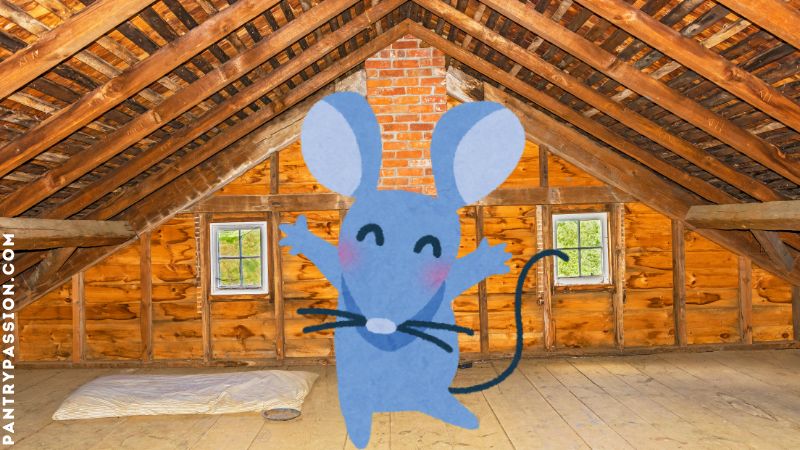The Best Fluffy Pancakes recipe you will fall in love with. Full of tips and tricks to help you make the best pancakes.

Attics pose unique rodent challenges: exposed insulation. From contaminated blown-in bits to chewed up fiberglass batting, it’s a major headache to deal with.
Let’s walk through how to remove mice from attic insulation, clean up the mess, and restore your attic to its peaceful, pest-free glory.
DON’T MISS Pantry Passion’s Complete Article List for Mouse & Rat Prevention!
Table of Contents
- When Mice Get Into the Insulation
- How to Get Rid of Mice in Attic Insulation
- Do You Have to Replace Attic Insulation After a Bad Infestation?
- DIY Attic Insulation Replacement
- Attic Insulation for Pest Control, Which is Best?
- Final Thoughts
When Mice Get Into the Insulation
IMPORTANT: if you suspect mice in your attic, you should act fast to minimize damage. Left unchecked, a small infestation can turn into a major renovation project. Replacing contaminated insulation and repairing chewed structures can be expensive.
Here is the potential damage and risks a pest infestation can cause:
- Mice gnawing on wires increases the risk of short circuits and can cause attic fires.
- Soiled or shredded insulation loses its ability to regulate temperature, resulting in higher electrical bills.
- Rodents shred fiberglass, cellulose, or foam to build nests, especially in winter; their presence can cause a health hazzard.
Can Mice Live in Attic Insulation?
Yes—and they love it. If left unchecked, it can become their permanent home for generations. Insulation offers:
- Warmth during cold months
- Quiet, undisturbed nesting spots
- Soft materials for burrowing and building nests
Whether it’s fiberglass, cellulose, or foam, mice will shred it, tunnel through it, and even chew on it. Check out my article on just exactly how mice survive in attics.
It’s also a deal breaker when buying or selling a house—another incentive to get your attic mouse issues under control.
How to Get Rid of Mice in Attic Insulation
Of course, prevention is everything. You couldn’t prevent the first wave of mice, but there are strategies to stop subsequent infestations. If you set traps around the parameter, or near the nest, you can catch them and then remove the mice: Step 1. Unlike poison, you have control where the mice die when using traps. With poison, mice could die under and in attic insulation or crawl into walls and other voids to die.
I go into another article about getting rid of mice in the attic and how to kill them, but it’s ultimately the same keystone advice: seal entry points. Rats, in particular, are very challenging to get rid of, because of their propensity to make their own entry points and their sheer intelligence factor.
But we’re talking about getting them out of the insulation. Poison bait will coax them out because they will take readily available food in the attic. Once rodents are dead and entry points are sealed, you can begin to deal with the soiled and damaged attic insulation.
If you read my article on how to keep mice out of cars and other vehicles, you will have come upon the strategy of using lights to force mice out of places you don’t want them. Strobe lights, in particular, are unbearable to mice and other critters living in your attic. Some people even resort to motion sensor lights or blinking Christmas light to chase out mice.
Let’s not forget sound. One guy stuck a blue tooth speaker up in the attic and blasted out his rats.
Do You Have to Replace Attic Insulation After a Bad Infestation?
If mice have nested extensively, left behind droppings, or contaminated the insulation with urine, replacement is strongly recommended.
Damaged insulation:
- Loses its effectiveness
- Can harbor bacteria and allergens
- May attract more mice due to lingering scent trails
Professional pest control often use specialized vacuums with hepa filters to remove soiled insulation and recommend replacing it with rodent-resistant materials like mineral wool or high-density spray foam.
Just to be safe, I marked known holes in insulation with blue tape (next to a ceiling brace, etc.). If I see a new hole, I know there is a new problem!
Farmwife Renee, PantryPassion.com
If It’s a Minimal Mouse Infestation
If this is just another routine mouse or two – even a rat in the attic—and rodents have been trapped, consider the problem minimal. I consider my attic under control. Just to be safe, I marked known holes in insulation with blue tape (next to a ceiling brace, etc.). If I see a new hole, I know there is a new problem!
I grew up in an old farmhouse with an attic big enough to walk around in. It was normal to find scattered dead flies, maybe a dead bird, and occasional mouse skeletons. There was no insulation (geez, I kinda think now it could have really needed it!).
Back in the day, we would have given it a good sweep. The “clean slate” allowed us to see any new activity. Now I know better. I would go in first and spray it all down with a disinfectant before kicking up mouse dust – and with a face filter on.
Mice droppings, urine, and nesting materials can pose serious health risks—not to mention lingering odors and damage to insulation.
Experts Weigh In: Should You Throw out Attic Insulation After a Rodent Infestation?
Be prepared for mixed answers. There has to be common sense involved. Quotes for full removal of old insulation, replacing it with new, and mouse proofing can run as high as $7,000-$10,000. Many pest pros say, in most cases, a full attic re-do is not necessary. If feces is old, and there is no evidence of current activity, then odds are you can pass.
Here are some comments from experienced Reddit members who shared their thoughts on this matter:
Reddit member TheBugSmith: “99% of the time I’m telling a customer it’s not necessary but there is that 1%. I’ve seen some that have so many holes from mice it’s not insulting anything at that point. If you had a minor mouse problem that’s been addressed the insulation will be fine.”
Reddit member Unusal_Hour1151: “I’ve been in pest control 20 years. If the tech sells the insulation, don’t listen to them… If you have a SEVERE infestation the insulation may need to be replaced. However, get more quotes from an insulation company as well.”
Go up in your attic and look at the insulation, does it look fine? Is it worn out?
-Reddit comment
Look up the recommended R value for attic insulation in your region, take a tape measure and measure how high your insulation goes from the drywall then multiply by 3, that’s your R value. If it’s under, and worn down from rodent piss and activity, then by all means replace it if you have the means.
Reddit member 604L: “I’ve done a few attic insulation removals but only because the customer was selling the home and it was a requirement in the sale agreement. I don’t ever re-insulate, not my scope of work. I hate doing removal so I price them high in hopes I don’t get these jobs and if I do the price allows plenty of time. $3-4k for a 1000-1200sq/ft attic, insulation removal/disposal, vacuum accessible surfaces, disinfect/deodorize is what I quote. Might be high but I f’n hate attics and hate insulation even more.”
Reddit member RaulTheAwful: “Attic insulation doesn’t need to be changed. It’s a vented attic. Air comes in through the soffits, and out through the roof vents. There is no significant air exchange between attic and house. Only time I would recommend having it replaced is if it was low, or if you were selling the house (in which case you would replace to not scare off buyers).”
Reddit member Electrical _Ad_6208: “Seconded. The big companies love selling these insulation jobs. Unless it’s significantly beaten down and degraded it’s not worth it.”
HeatherBaby_87 from Reddit commented, “I personally will only suggest replacing insulation in extreme infestation situations where the whole attic is riddled with urine, feces, burrow holes everywhere you look…other than that I suggest other options.”
One user added, “a complete insulation removal and reinstall is almost never needed. Usually, remove contaminated areas and blow over the top with new insulation… I would tell the homeowners to get several restoration quotes.”
When IS it Bad Enough to Replace the Attic Insulation?
How much feces and urine would it take to recommend to a customer to replace their attic insulation? It’s a question a lot of people ask, because it seems like a money grab. It can cost thousands of dollars to replace insulation in attics (that’s why most people just leave it).
The truth is, companies are not excited about attic work – it’s hot and dirty. Insulation removal/exclusion services cost varies by job. As one person put it, “there are so many details that can make the job go slower.” Consider the time to go up and down stairs, taking extra care stepping through prized living rooms, number of holes to patch, etc.

It takes a real pest control expert who has “seen it all” to decree – “Whoa! This is really bad!” Yes, it can be psychological torture to know that mice and rats have been in your attic. Is it bad enough to dump $10,000 into a complete reset? Most people would say no. For peace of mind, just pay for an attic inspection with someone you feel you can trust to get an expert’s opinion.
There are a couple of things you can do before dropping money:
- Inspect your attic with your own eyes.
- The pest control person should provide you pictures/videos of evidence.
- The exclusion service should include sealing up entry points – if not, what’s the point?
- Get multiple bids AND opinions – you’ll be shocked. It’s your job to hold on to your wallet!
Replacing and cleaning your attic is no guarantee the rat or mouse problem is fixed. There was a guy who went through an energy audit, then blew another 16″ of cellulose on top of the existing insulation bats. The bats were easy to move, lift up, and inspect. He took the opportunity to mouse proof when he could easily see mouse entry points. After all that work, the mice still got in.
Best advice: Seal up entry points outside and bait like crazy in the attic.
Attic Re-Insulation Considerations
Random things to consider on your attic insulation journey:
- Do not replace the insulation without sealing any entry points. You’ll have nice new insulation with an active rodent infestation.
- You might be able to get tax credits for re-insulating.
- Mobile home: most companies won’t touch them because the insulation is different than a stick built home.
- Have an energy audit done and a thermal scan to determine air leaks.
- If you’re an amateur, it might be time for the pros. They understand the importance of attic air circulation. If you accidentally block vents, you can create a mold problem.
DIY Attic Insulation Replacement
Here’s the gist of going on your own to replace attic insulation:
- Remove contaminated insulation: Wear protective gear or hire a pro to vacuum (with hepa filter) and dispose of it safely.
- Disinfect the attic: Use enzyme cleaners or diluted bleach to kill bacteria and neutralize odors (the scent trails that signal other rodents to return).
- Replace insulation: Choose materials less attractive to rodents and restore your attic’s energy efficiency.
If you are considering DIY attic removal, remember, there might be a compromise. Maybe you can work it out with a contractor that you remove the old insulation to save some bucks, and they do the rest.
ALERT: There is a possibility of mortgage rejection or reselling your home if you have spray foam in your home in the UK that has increased moisture issues and structural integrity.
-Source: The Guardian
Here is more advice on the attic insulation removal process:
Reddit user EagleWatch1945: “This could be a good time to think about upgrading to spray foam. Short of that, batt insulation isn’t that expensive and is relatively easy to install (measuring and cutting are the most difficult parts).
Removing old batt insulation ain’t so bad. Tyvek suit, filtration mask and goggles, nitrile gloves, maybe a headlamp, and 50 gallon trash bags. Pull it, roll it, and bag it. Get in there with a shop vac afterwards [with hepa filter]. I did this back in August in prep for spray foam insulation. Cost me a Sunday, $50 for my safety gear, and $300 for a haul away (I had about 2 dozen 50 gallon bags).”
ltdan993 adds for cellulose, loose insulation: “If you don’t have the batt insulation you will need an industrial suck out machine and will need a large truck to haul away the old insulation (they do rent these machines). However you will want at least 2 people to run that machine. One sucking out and one watching the bag and changing it when it gets full.”
Attic Insulation for Pest Control, Which is Best?
Consider a comparison between three different types of attic insulation: cellulose (loose) insulation, batt insulation (fiberlass/Rockwool), and spray foam insulation in regards to keeping mice and other pests at bay:
| Feature | Cellulose Insulation | Batt Insulation (Fiberglass/Rockwool) | Spray Foam Insulation |
|---|---|---|---|
| 🐭 Rodent Nesting Potential | Low – dense and hard to tunnel through | High – soft and easy for rodents to shred/nest in | Very Low – hard surface, not suitable for nesting |
| 🧪 Pest Deterrents | Treated with borates (natural pest repellent) | Typically untreated | Not chemically treated, but naturally uninviting |
| 🔧 Installation Gaps | Fills cavities tightly, reducing entry points | Can leave gaps if not installed properly | Seals gaps and cracks completely |
| 💧 Moisture Resistance | Good with vapor barriers | Can trap moisture, attracting pests | Excellent – acts as moisture barrier |
| 🛠️ Durability Against Chewing | Moderate – not preferred by rodents | Low – rodents easily chew through it | High – difficult for rodents to chew through |
| 🧱 Barrier Effectiveness | Works well with air sealing | Needs additional sealing | Excellent – acts as air and pest barrier |
| 💰 Cost | Moderate | Low | High – more expensive upfront |
| 🧹 Maintenance & Longevity | May settle over time | Can degrade or shift | Long-lasting and low maintenance |
SUMMARY
- Spray foam insulation offers the best rodent deterrence due to its sealing properties and tough texture.
- Cellulose is a solid middle-ground option with natural pest-repelling additives.
- Batt insulation is the most vulnerable to rodent activity unless paired with strong physical barriers.
Nealon Insulation states that none of these insulation products comes with a “no pest” guarantee—but when installed properly, make your home less inviting to rodents.
Cellulose insulation tends to be less inviting to rodents due to its density and pest-repellent treatment, while batt insulation—especially fiberglass—is more nest-friendly and prone to chewing (mice and rats prefer insulation that’s easy to shred), unless paired with strong air sealing and physical barriers. According to Pest Clue, “Spray foam insulation is less attractive to mice because it hardens and does not provide good nesting material.”
Let’s not forget the fun factor (or not): loose insulation sucks to dig through and inspect for mice. Fiberglass bats, on the other hand, can easily be pulled up and examined. Some people even set mouse traps under them.
Are There Mouse-Proof Insulation Brands?
A homeowner with rodent problems was recommended TAP insulation because it deterred insects and cellulose is hard to nest in because it collapses in on itself.
Reddit member SuperNateinNS responded: “TAP’s boric acid won’t do anything to rodents but it does a great job on insects that come in contact with it. The only thing it does for rodents is fall in on itself if they try to tunnel through it. Rolled insulation or rock wool allows them to build nests under it.”
Final Thoughts
If you’re left thinking, “OK, I won’t replace my attic insulation” you’re probably right, I’m glad I talked you into avoiding that expense. However, I’m not an expert and this advice cannot apply to every unique situation. When in doubt, get more opinions about what happening under your own roof.










